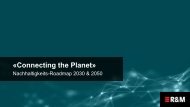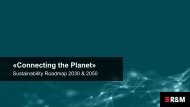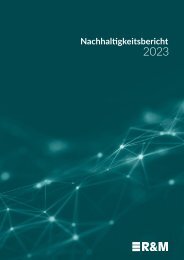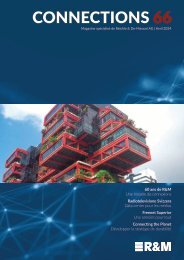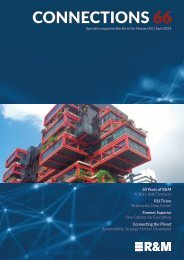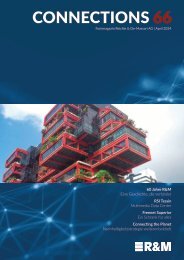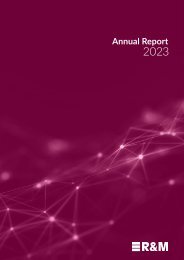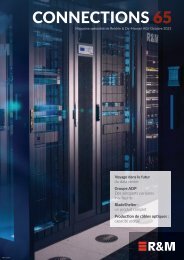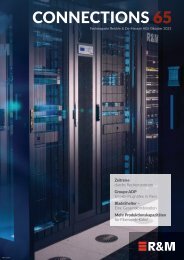R&M Sustainability Report 2023
R&M Sustainability Report 2023
R&M Sustainability Report 2023
Create successful ePaper yourself
Turn your PDF publications into a flip-book with our unique Google optimized e-Paper software.
Double Materiality Assessment<br />
Double Materiality<br />
Expanded Perspective<br />
Is R&M focusing on the most relevant sustainability tasks? Companies like R&M<br />
need to ask themselves this question on a regular basis to further develop the strategy and<br />
focus on the most important and relevant aspects. A «Double Materiality Assessment»<br />
provides clarity and orientation.<br />
For the first time, R&M is presenting a<br />
double materiality assessment. It helps to<br />
plan sustainability activities more objectively.<br />
Analytical processes and reporting were<br />
continuously refined during the reporting<br />
year to identify material issues and risks in<br />
more detail.<br />
The double materiality assessment indicates<br />
which environmental, social and governance<br />
(ESG) issues are considered urgent or material.<br />
It discloses which aspects could have<br />
a significant impact on the company and<br />
which may have received insufficient attention<br />
so far.<br />
The analysis is an ongoing process and will<br />
be repeated every three years to identify<br />
changes and new issues at an early stage.<br />
In this way, internal stakeholders and risk<br />
management are supported with conclusions<br />
for the continuation of the strategy, objectives,<br />
and measures. The steering team monitors<br />
and refines the targets and ongoing<br />
indi vidual measures annually and defines the<br />
degree of target achievement using defined<br />
key figures.<br />
Two perspectives<br />
The importance of topics, opportunities and<br />
risks can be considered both internally and<br />
externally according to the principle of double<br />
materiality.<br />
• Environmental and social materiality implies<br />
an inside-out perspective in which<br />
companies examine the external effects<br />
of their activities, including the effects on<br />
society and the environment.<br />
• The outside-in perspective shows how<br />
relevant the external influence (environment,<br />
society, and compliance) is for R&M.<br />
This involves aspects that could influence<br />
or endanger the future profitability and<br />
operational capability of the company.<br />
The analytical process was based on the latest<br />
recommendations from, among others,<br />
the Boston Consulting Group (BCG). Standardized<br />
frameworks from the following<br />
institutions served as additional orientation:<br />
EU CSRD Directive, European Financial<br />
<strong>Report</strong>ing Advisory Group AISBL (EFRAG),<br />
<strong>Sustainability</strong> Accounting Standards Board<br />
(SASB), Task Force on Climate-related Financial<br />
Disclosures (TCFD), MSCI Inc., Global<br />
<strong>Report</strong>ing Initiative (GRI).<br />
Four steps<br />
The double materiality assessment is based<br />
on four steps:<br />
for feedback (step 3). The categories were<br />
determined through internal interviews and<br />
benchmarking. The above-mentioned frameworks<br />
were used for this purpose. In addition,<br />
ten internal and external stakeholder<br />
groups were identified to be involved in<br />
step 2.<br />
Step 2, Preparation: Individuals who are<br />
important or representative for R&M were<br />
selected for each stakeholder group. The<br />
distribution corresponds to the geographical<br />
and business importance of R&M. In addition,<br />
the stakeholders were weighted based<br />
on their relevance for R&M.<br />
«More than 100 people<br />
participated in the<br />
anonymous online survey.»<br />
Step 3, Execution: The individuals identified<br />
in step 2 were invited to take part in an<br />
anonymous online survey. A total of more<br />
than 100 people participated. The evaluation<br />
by the steering team is presented in the<br />
matrix on page 11. The results were analyzed<br />
and discussed internally in additional indepth<br />
interviews to better assess risks and<br />
identify opportunities at an early stage.<br />
Step 1, Exploration: The steering team drew<br />
up a shortlist of 19 topic categories (the<br />
three highest rated topics are described<br />
in the text; all other topics are listed in the<br />
table on page 30) and asked stakeholders<br />
8 | R&M <strong>Sustainability</strong> <strong>Report</strong> <strong>2023</strong>






